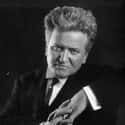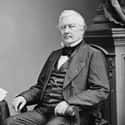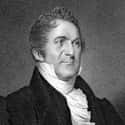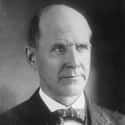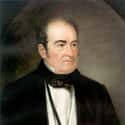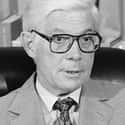(#10) Robert M. La Follette, Sr.
- Dec. at 70 (1855-1925)
Election Year: 1924
Party Affiliation: Progressive Party
Percentage of Vote Won: 16.6%
Robert La Follette Sr. had previously attempted to win the Republican nomination in 1912, but was thwarted by Teddy Roosevelt's entry into the race. When Roosevelt decided to form his Progressive "Bull Moose" Party, La Follette declined to join him. Instead, La Follette formed his own Progressive Party in the wake of the collapse of the Bull Moose movement.
This center-left party coalesced around government regulation of business, populist political reforms, and an isolationist foreign policy. La Follette was thumped by the sitting president, conservative Republican Calvin Coolidge, who enjoyed wide popular support thanks to a booming, pre-Great Depression economy. Conservative economic policy won the day until the election of Franklin Roosevelt and his New Deal platform.
(#4) Millard Fillmore
- Dec. at 74 (1800-1874)
Election Year: 1856
Party Affiliation: American Party
Percentage of Vote Won: 21.5%
Another former president seeking to return to power, Fillmore stood for the American Party, better known as the "Know Nothings," named after their cagey responses to non-party members asking for details of their organization. The previously dominant Whig Party had collapsed, the fight over slavery was reaching a fever pitch, and sitting Democratic president Franklin Pierce was so unpopular that he failed to win the nomination of his own party. This instability was an ideal breeding ground for a fringe third party to grab the national spotlight.
Echoes of the Know Nothings' party platform can be seen in today's politics: distrust of immigrants, the deportation of "undesirables," state-mandated religious education, strong government regulation of private industry, and the expansion of rights for minorities and women. The Know Nothings, while ostensibly anti-slavery, focused most of their attention on the hatred of immigrants and Catholics, making them one of the first isolationist movements in American politics. Fillmore won a significant percentage of the popular vote, but only captured one state, Maryland, netting him a scant eight electors. This would be the final presidential election to feature a Know Nothing candidate, as the Civil War made questions of immigration far less pressing.
(#2) William Wirt
- Dec. at 62 (1772-1834)
Election Year: 1832
Party Affiliation: Anti-Masonic Party
Percentage of Vote Won: 7.78%
Like John Floyd, William Wirt attempted to unseat Andrew Jackson in 1832. Wirt represented the Anti-Masonic Party, which, as the name states, was a political group dedicated to crusading against the fraternal organization known as the Freemasons. It was the belief of the Anti-Masonic Party that the Freemasons were part of a vast global conspiracy. The Anti-Masons were an early iteration of the American populist movement - highly skeptical of the elites, and against modernity and the exclusivity inherent in the Masonic organization.
Wirt took Virginia, defeating that state's sitting governor, John Floyd. Elsewhere in the country, he struggled, and this iteration of the Anti-Masonic Party dissolved eight years later.
(#9) Eugene V. Debs
- Dec. at 71 (1855-1926)
Election Year: 1912
Party Affiliation: Socialist Party
Percentage of Vote Won: 5.99%
Eugene Debs was, in a sense, the Bernie Sanders of his time. Debs was the standard-bearer for socialism in America for decades, running five long-shot presidential campaigns via the Socialist Party (including one run undertaken from prison after being incarcerated for speaking out against WWI).
Debs had his best showing amidst the chaos of 1912, though he carried no states. His support for labor movements and workers' rights, combined with his passionate oratory, made him the most popular socialist figure in American politics. Thanks to his efforts, the Socialist Party survived until 1972, as the polarization of US politics made niche parties less viable and socialism temporarily fell out of favor.
(#6) John Bell
- Dec. at 73 (1796-1869)
Election Year: 1860
Party Affiliation: Constitutional Union Party
Percentage of Vote Won: 12.6%
John Bell served as the first and only presidential candidate for the Constitutional Union Party, a coalition of former Whig and Democratic Party members who sought to heal the schism between North and South. Members of this party were dissatisfied with both the Republicans and Democrats, who carved out intractable positions on slavery.
Former Speaker of the House and Secretary of War John Bell served as the party's candidate in 1860, with the explicit aim of preventing either party from collecting enough electoral votes to win the presidency. In that event, the question of who would serve as the next president would fall to a vote of the House of Representatives. Despite collecting one of the lowest percentages of the popular vote ever for a victorious presidential candidate, Abraham Lincoln won, which some would say was due to the splitting of the vote caused by Bell and Breckinridge.
(#13) John B. Anderson
- 97
Election Year: 1980
Party Affiliation: N/A
Percentage of Vote Won: 6%
The 1980 election proved to be a decisive victory for Ronald Reagan and the Republican Party, but it was not without its hiccups. President Jimmy Carter had proven to be a highly unpopular chief executive thanks to the Iran hostage crisis, a sputtering economy, and high gas prices, and had to weather a primary challenge from Senator Ted Kennedy. On the Republican side, former California Governor Ronald Reagan competed against a wide variety of opponents, which included George H.W. Bush, Bob Dole, and Illinois congressman John Anderson.
Anderson fell to Reagan, but chose to mount a quixotic independent run in the general election. Anderson hoped to be a more moderate alternative to Reagan's conservative message of supply-side economics, increased military spending, and cutbacks on social programs. Anderson took no states in the face of Reagan's historic landslide victory.
New Random Displays Display All By Ranking
About This Tool
In presidential elections, although third-party candidates always end in failure, the third-party candidates running for election does not make any sense if only success and failure are considered. From the perspective of political development, the participation of third-party presidential candidates is still very meaningful. First, although Republicans and Democrats monopolize most of the public offices of the US Federal Congress and state governments, sometimes third-party candidates still have individual successful political figures in presidential elections or governor elections.
The random tool lists 14 of the most viable third-party presidential candidates in history who were also influential in the United States, their contributions can not be ignored.
Our data comes from Ranker, If you want to participate in the ranking of items displayed on this page, please click here.











